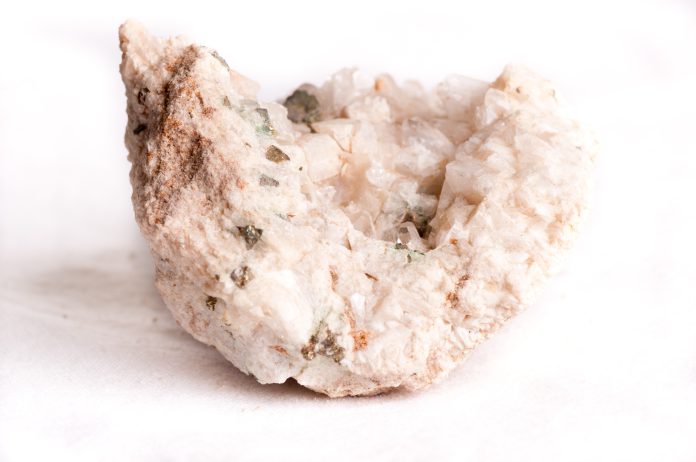
Pink danburite may be the new girl’s best friend. They say diamonds are a girl’s best friend but for those looking for a dazzling gemstone that is far rarer than any diamond, pink danburite is the superior choice.
“The natural, light pink variety of danburite is found in only one location in the world— San Luis Potosi, Mexico — the La Aurora mine region. This is a very unique, yet heavily undervalued gem,” said Ales Patrick Krivanek, owner of Ravenstein Gem Company, LLC which has provided top-quality gems for artists and jewelers from throughout the world for over four decades. “Most of the world still hasn’t discovered this rare, beautiful and unique gemstone.”
The mineral danburite was initially identified in 1839 in Danbury, Connecticut, by mineralogist and lecturer at Yale University, Charles Upham Shepherd. Krivanek said, “The original mine was literally covered by the expanding city,” he said, noting that the stones found in Connecticut were completely colorless, more like a white diamond or quartz. And while these, along with the golden-hued or tan danburite are all beautiful, the pink danburite stands out in rarity.
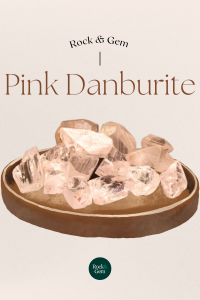
Catching the Eye of Artists
Renowned gemstone artist Maja DuBrul discovered the exceptional qualities of pink danburite over two decades ago and loves incorporating it into her timeless designs that remain in step with the most cutting-edge fashions.
“Everybody loves big and glittery,” she said. “(Danburite) is a bigger presence. It’s given me the freedom to make bigger pieces that do not overwhelm and are not crass.”
“I love to use pink danburite with turquoise,” DuBrul noted. The eye-catching sparkle of the danburite highlights the vibrant coloration of turquoise. The danburite is equally complimentary with more subtle gems, such as kunzite or mother of pearl, creating jewelry that is a conversation piece, as well as a beautiful accent for any occasion.
With a foundation in art history, DuBrul understands the elements that make pieces popular for generations, and pink danburite offers the brilliance and sparkle appeal that never fades in fashion. She said, “The jewelry isn’t something that’s going to be thrown to the side because it will be dated in a year or so. That’s the goal.”
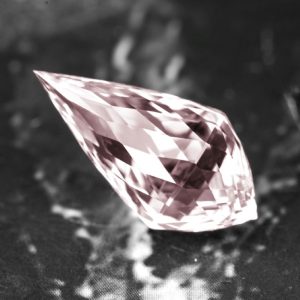
A Gem Cutter’s Perspective
Beyond its eye-catching qualities, the attraction of pink danburite is that it checks all the boxes for gemstone artists. “The cutter must know about the material they are cutting,” said Krivanek.
“The hardness is not crazy,” said Krivanek. “Pink danburite from La Aurora has an average 7.5 Mohs Scale of Hardness, similar to tourmaline, aquamarine, andalusite, and several types of garnets such as pyrope, almandine and Malaya garnet. Therefore, this gemstone is perfect for unrestricted jewelry wear.”
“It’s also one of the easiest gemstones to cut,” he said. Krivanek explained that many gemstones develop cleavage planes as they grow in their natural environment.
“If you hit the gemstone along the cleavage plane, it can possibly crack,” he said. “But danburite has no cleavage plane in any direction.” Because of this, he said it behaves uniformly, which means that the artist can cut it faster and not worry as much about fracturing the stone.
Pink Danburite’s Dazzling Appeal
“The incredibly high light dispersion (fire) properties of the material from the La Aurora mine make well-faceted gems look like diamonds, splitting light into a rainbow of colors,” said Krivanek. “This effect (in both diamonds and danburite) is seen in smaller, such as 5mm to 8mm, round-cut gems.”
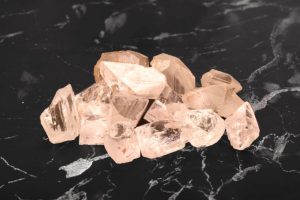
Courtesy Ravenstein Gem Company and Ales Patrick Krivanek
Big & Bold Gems
When it comes to using pink danburite for jewelry, one of the most popular characteristics is the gemstone can occur in larger sizes that offer visual impact to the piece.
“When it comes to faceted danburite for jewelry, collectors and investment purposes, the vast majority of these gemstones will cut individual pieces between two carats and six carats. This is actually the sweet spot and the ideal range for jewelry making,” said Krivanek. “Cut gems over 10 carats are already quite rare, and gemstones over 20 carats are extremely rare.”
With that said, he noted that the largest danburite his company ever cut was approximately 135 carats. “But about half of the stone did have some moderate natural inclusions,” he said. Even though that stone was not suitable for cutting at the maximum size, he said the largest clean-faceted stone he’s worked with registered an impressive 73 carats.
Pink Danburite: Polished to Perfection
For many gemstone artists, the gem is not complete until the final polish, which can make or break a piece because even though the facets might be precise, fine scratches can dull the appearance.
“When you take amethyst or citrine, they can be really tough when it comes to polishing,” said Krivanek “Danburite takes on a beautiful polish. It is easy to cut and easy to polish. There’s not much negative.”
Spreading the Word From its Source
Precious stones are defined by rarity, beauty, perfect clarity, sufficient hardness, and attractive colors. Krivanek said, “Danburite checks all of these boxes and more.” It’s a bit puzzling that artists are not clamoring over pink danburite.
“It’s so unknown,” said Krivanek. “It has a low visibility on the market, regardless of how beautiful and literally perfect the gemstone is.” He said when he attends some of the large gem shows nearly 99% of the people will inquire about the danburite on display, and for those that know what it is, they tend to think it’s just a cheap stone.
But over the decades, his goal has been to let artists and collectors know about the gems’ beauty and exceptional qualities. “I saw the potential in this gemstone 35 to 40 years ago,” he said. “I didn’t have access to the mine, but I knew the head geologist.”
Krivanek pointed out that pink danburite comes from a single source in a similar fashion to tanzanite and Oregon sunstone.
But there’s a twist. Instead of targeting the gem in specific gem prospecting ventures, Krivanek said that it is found within a large-scale sphalerite (zinc ore) mine, brought up from the kilometer-deep tunnels large enough to drive the enormous trucks through the underground workings.
“Most mines produce various gemstone species,” he said. “This one produces only one, which is pink danburite.”
Krivanek explained that the pink danburite is found in rarely occurring gemstone-rich pockets during the zinc ore extraction, and when this happens, the miners bring the gems to the surface. He picks the best from these discoveries.
“Many people do not realize that similar situations exist with many other commercial metal ore mines where the actual gems are practically a byproduct of the mineral or metal ore production,” he said. “Interestingly enough, this byproduct is many times much more valuable compared to the value of the actual commercial material being mined.”
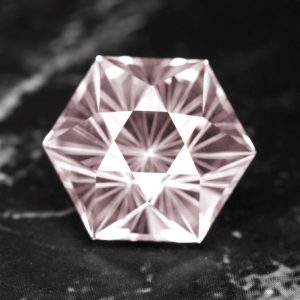
Pink Danburite: A Beautiful Investment
Throughout history, gemstones have always been a symbol of wealth and status, holding their value despite economic and world events. “This is why gemstones were always the top preference in wealth gathering and preserving. Only during the last century did people somehow forget about this type of investment. Gems have been a staple of wealth for the ruling class and rich and famous for millennia,” Krivanek said.
Over the past couple of decades other gems, such as blue spinel and tourmaline, increased their value as markets opened and artists discovered their value, but Krivanek firmly believes that pink danburite, along with natural zircon, are two of the most undervalued gems at the present time that are still waiting to be discovered by the artists, jewelers and general public.
“The situation improved but it’s nowhere near where it should be,” he said, which is why he continues to buy the best from the mine.
“It hasn’t sparked attention,” Krivanek said, “But the world is running out of gemstones.” It’s only a matter of time before faceting and jewelry artists, along with collectors and investors, realize the magic in this subtle-hued, yet stunning, gem that is the perfect medium to express their creativity in the most dazzling way possible.
This story about pink danburite previously appeared in Rock & Gem magazine. Click here to subscribe. Story by Amy Grisak.















